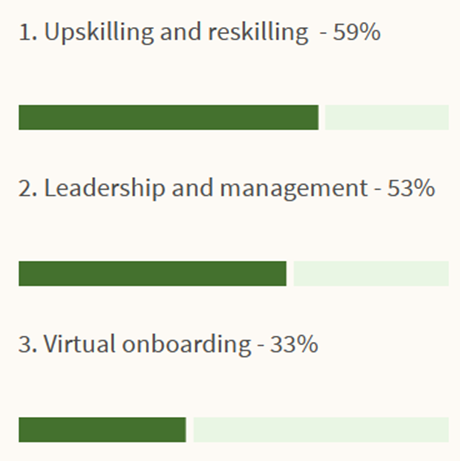In our previous blog post, we wrote about the importance of identifying skill gaps in the workforce and how L&D teams should work closely with HR and the project management teams to adequately upskill and reskill employees. We looked at some key reasons why employees are quitting their jobs and how L&D teams can provide employees an opportunity to gain new skills and shift to new roles within the same organization to beat the monotony of regular work. In this blog post, we will focus on the importance of managing talent effectively during these uncertain and challenging times, the importance of investing in employee learning, and how L&D teams can deploy agile skill development programs to foster learning and motivate employees within the organization.

Table of Contents
Talent Management in a Post-Pandemic World
What Covid-19 has taught organizations and L&D leaders is that a majority of the employees are happy working from home or adopting a “hybrid” work model. As economies open up and companies slowly start welcoming employees back to the office; HR and L&D leaders are in an unenviable position of adding extra value to entice and attract employees to work from the office. We saw in our previous blog post about “The Great Resignation” and how a growing number of skilled employees are looking at freelance gigs and independent consulting to break away from the traps of a regular 9-to-5 job at one organization.
There is a growing need to build an employee culture that goes outside the traditional workplace. In the last year, we have seen thousands of posts on LinkedIn with people sharing photographs of wellness gifts shared by their respective organizations. Ranging from healthy food hampers to eco-friendly stationery and gym subscriptions to personal development books; organizations are going all out to retain their employees and attract new talent. In the next section, we will examine how and why nurturing the skills of employees is crucial to an organization’s growth.
Looking Beyond Gifts with Skill Development for Talent Management
What makes an employee happy? A hypothetical question with a list of possible answers:
- Work-life balance
- A good salary
- Rewards and benefits
- Health insurance cover
- A supportive manager
- Transparent performance appraisals
- Performance-linked bonuses
- Opportunities to learn new skills
Most organizations claim to offer the points listed above. But over a period as people change and decision-makers in organizations have new goals listed for developing the organization, priorities change. Successive LinkedIn Workplace Learning Reports over the years have stressed on the importance of “happy employees” and how organizations that offer an environment that fosters learning are likely to retain talent.
The LinkedIn Workplace Learning Report – 2021
In the latest LinkedIn Workplace Learning Report; the unanimous focus point for L&D professionals from around the world was – “Upskilling and Reskilling of the Workforce”. This is ample proof why it is important for the L&D team to focus on upskilling and reskilling employees to help them prepare for the challenges posed by evolving businesses and competitors.
As per the report, the top three priorities for L&D teams were:

Why Should Organizations Invest in Employee Learning?
One of the best things that organizations can do is to invest in a strong learning culture and provide many opportunities for employees to learn new skills and grow in their careers. By fostering an inclusive culture of learning and growth; organizations can demonstrate that they really care for their employees. Why do some organizations garner a lot of respect from their employees? Have you ever considered why some organizations have a high rate of employee resignations whereas there are organizations with employees who have put in over a decade of service?
One of the key factors that contributes to employee happiness and satisfaction is “learning and growth.” Organizations that tend to care for the professional and learning curve of their employees are the organizations with happy employees. Happy employees translate to a positive work environment. A positive and energetic work environment ensures that employees are truly invested in their work and really care for the growth of the organization. The passion and dedication shown towards one’s work increases exponentially. This is the reason organizations must actively focus on investing in the learning and growth of their employees. Employees care for empathy, frank and transparent conversations about work, and opportunities to learn new skills and take up new and challenging projects. In this interesting article written by Margaret Rogers, we learn about some steps that can be taken to identify, develop, and retain talent in an organization.
Upskilling and Reskilling Versus Regular Training
One key factor that we need to remember is that upskilling, and reskilling is different from regular workplace training. When we conduct a training program for new hires or run an onboarding program it is akin to treading fresh ground for the employees. Reskilling or upskilling is a result of a detailed analysis of the employees’ current skillset. It is based on how the organization perceives their role in the near future, where they will be a good fit, and then choosing to train them in a specific skill set to help them excel at the role that the organization has in mind for them.
Options Available for Upskilling Employees as part of Talent Management
Different forms of training like in-person workshops, self-paced learning, microlearning delivered via mobile apps, instructor-led training programs, virtual instructor-led training programs, and blended learning are available to help train employees and upskill them.
What makes Virtual Instructor-Led Training a Powerful Tool for Skill Development?
The following paragraph extracted from the LinkedIn Workplace Learning Report 2021, offers an interesting insight into why virtual instructor-led training is the key to reskilling and upskilling of employees.
“That means that the pivot L&D made from instructor-led training (ILT) to blended online learning — learning experiences with a mix of virtual instructor-led training (VILT) and online learning — will remain the status quo.”
Virtual instructor-led training programs or blended learning programs are a powerful way to offer the best of both self-paced eLearning and a guided learning experience. One can design the programs in such a way that learners and instructors can communicate in real time from within an LMS or LXP or are able to communicate using email or Skype. The presence of a human teacher or instructor or an animated avatar or bot that guides the learner through the program; ensures retention of learning and provides an engaging learning experience. It is also an opportunity for individuals to come together, collaborate during and beyond the training period. An opportunity to nurture teams in an otherwise isolated environment. VILTs can be designed from scratch or be created by repurposing existing printed or slide-based learning content. The aim is to offer a guided learning experience that helps learners achieve their goals.
This short video here illustrates how organizations can capitalize on the benefits of VILT.
The Origin Learning Advantage
Would you like to discuss further about addressing training needs through VILT? With an experience of developing 8000+ hours of training content, Origin Learning has successfully curated skill-based curriculums for leading organizations. Write to us at info@originlearning.com for more information.
